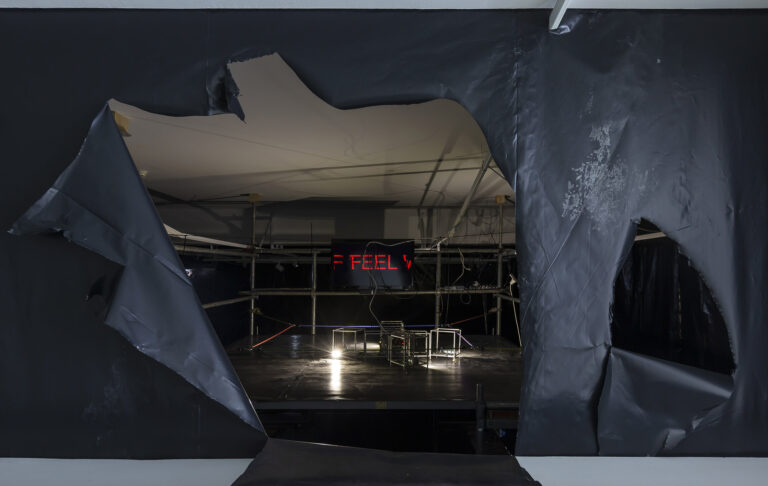Artists: Jakub Choma, George Crîngaşu, Botond Keresztesi
Exhibition title: Contours arise from cold diode-rays
Curated by: Áron Fenyvesi
Venue: Horizont Gallery, Budapest, Hungary
Date: September 6 – October 11, 2017
Photography: all images copyright and courtesy of the artists and Horizont Gallery
The group exhibiton of Horizont Gallery showcases a curatorial selection of works of three young Central-Eastern European artists, which is focused on the connections of the artistic positions to figurality. Even the epoch of 21st century digital images couldn’t abolish the relevance of figurailty in art, as earlier the emergence of photographic representation didn’t make figures completely dissapear from painting. Instead a new generation of artists matured in the context of extreme-widely accesible digital images, and they instictly adopted their visual strategy to the language of digital image editing. The paradigm-shift of the new generation is not really technical nor technological, rather it adresses the structure of images, and of course brings along new content and topics. The newly found figurality is not deattachable from contemporary visual culture, the painting of this new generation is reinvented throught the filters of contemporary graphic design, thus is contains much less painterly gestures even than previous photorealistic tendencies. The new figural painting which is built on the foundation of graphic design, accumulates and homogenises piles of hybrid images and a wide-range of new textures and it is also strongly dependant on the technique of collages, which puts the play of surrealist legacy also into motion.
The art of Budapest-based and Romanian-born Hungarian artist Botond Keresztesi is relatively known for the audience of Horizont Gallery as he had multiple solo-exhibitons here in the past years. Keresztesi’s paintings are dominantly graphic-design inspired, which reature many figures with strong outlines. Visuality of brands, advertising, stock-photos mix with iconic images of art history in a Magrittean-nature on the strikingly ironic canvases of Keresztesi, which recently appeared in a broader international context as well.
George Crîngaşu’s work had been also exhibited in Budapest in 2015 in Trafó Gallery. Crîngaşu’s 3d rendered images also rely as much on the stock-photo visuality as the paintings of Keresztesi. The defining difference between their art is more of a technical character as Keresztesi paints, while Crîngaşu is creating c-prints and compiles videos out of his imagery. Moreover Crîngaşu relativises and pushes well over the boundaries of kitsch the fetishised status symbols featured in his images. He uses the technique of accumulative over-piling and games of optical illusion for this purpose. George Crîngaşu had his last solo exhibition in Mihai Nicodim Gallery in Bucharest and he is one of the facilitators of Superliquidato, an artist-run-space in the Paintbrush Factory of Cluj-Napoca.
The youngest exhibitor of the show is the Kosice-born Jakub Choma who is still studying in the Academy of Fine Arts in Prague. The base of the painterly motifs of Choma is an expanding text and image-bank, which he constantly collects from the web and later on he transforms this pool into paintings on his canvases. Choma’s newest series which consists of four, relative big paintings is making it’s debut in Budapest. The popular culture of the late ’90s is also a strong inspiration for the artist as he centered a previous cycle of his around the characters of Scooby Doo. Choma’s new paintings are also based on cartoonish figures appearing in a strongly abstract visual context, with many different texture layers, and the artist also applies texts and objects to the surface of his works.




































